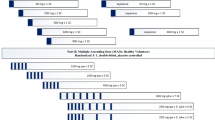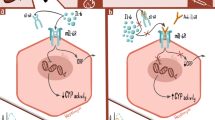Abstract
Objective
To investigate the impact of persistent inflammation in hemodialysis (HD) patients on the pharmacokinetics of alprazolam, a cytochrome P450 (CYP) 3A4 substrate, and its metabolites and the role of HD in the impact of persistent inflammation in this clinical context.
Methods
The study population comprised 26 HD patients (mean age 64 years, range 27–79 years; 19 men, 7 women) who were given 1 mg of alprazolam orally in the evening before the day of HD. Unconjugated and conjugated alprazolam and its 4-hydroxy and α-hydroxy metabolites were measured by liquid chromatography–mass spectrometry at 10, 34 (start of HD) and 38 (end of HD) h after intake. C-reactive protein (CRP) was measured weekly beginning 2 months before study initiation, and alpha 1-acid glycoprotein and 4β-hydroxycholesterol were measured at baseline. CYP3A4 activity was estimated as the ratio of unconjugated alprazolam to 4-hydroxyalprazolam between 10 and 34 h following alprazolam intake.
Results
After a single dose of alprazolam, plasma concentrations of unconjugated alprazolam and its metabolites decreased gradually, and unconjugated 4-hydroxyalprazolam was eliminated more rapidly than unconjugated alprazolam by HD. In contrast, the plasma concentrations of conjugated alprazolam and its conjugated metabolites increased during the 34 h following drug intake and the subsequent HD decreased their levels by almost 80%. The ratio of unconjugated alprazolam to 4-hydroxyalprazolam was correlated with CRP levels (r s = 0.49, P = 0.01). There was no significant correlation between CYP3A4 activity measured by alprazolam (4-hydroxylation) and alpha 1-acid glycoprotein or 4β-hydroxycholesterol. Conjugated alprazolam was also found in the plasma.
Conclusions
The correlation between CYP3A4 activity (assessed by alprazolam 4-hydroxylation) and CRP level suggests that inflammation may downregulate CYP3A4 activity. If confirmed, this could have major implications for drug dosing in persistently inflamed patients.




Similar content being viewed by others
References
Morgan E (2009) Impact of infectious and inflammatory disease on cytochrome P450-mediated drug metabolism and pharmacokinetics. Clin Pharmacol Ther 85:434–438
Xu D, Wang J, Sun M, Chen Y, Wei W (2006) Lipopolysaccharide downregulates the expressions of intestinal pregnane X receptor and cytochrome P450 3a11. Eur J Pharmacol 536:162–170
Robertson G, Liddle C, Clarke S (2008) Inflammation and altered drug clearance in cancer: transcriptional repression of a human CYP3A4 transgene in tumor-bearing mice. Clin Pharmacol Ther 83:894–897
Kacevska M, Robertson G, Clarke S, Liddle C (2008) Inflammation and CYP3A4-mediated drug metabolism in advanced cancer: impact and implications for chemotherapeutic drug dosing. Expert Opin Drug Metab Toxicol 4:137–149
Morgan ET, Goralski KB, Piquette-Miller M, Renton KW, Robertson GR, Chaluvadi MR, Charles KA, Clarke SJ, Kacevska M, Liddle C, Richardson TA, Sharma R, Sinal CJ (2008) Regulation of drug-metabolizing enzymes and transporters in infection, inflammation, and cancer. Drug Metab Dispos. 36(2):205–216
Nolin T, Naud J, Leblond F, Pichette V (2008) Emerging evidence of the impact of kidney disease on drug metabolism and transport. Clin Pharmacol Ther 83:898–903
Stenvinkel P, Carrero J, Axelsson J, Lindholm B, Heimbürger O, Massy Z (2008) Emerging biomarkers for evaluating cardiovascular risk in the chronic kidney disease patient: how do new pieces fit into the uremic puzzle? Clin J Am Soc Nephrol 3:505–521
Säwe J, Kager L, Svensson Eng J, Rane A (1985) Oral morphine in cancer patients: in vivo kinetics and in vitro hepatic glucuronidation. Br J Clin Pharmacol 19:495–501
Molanaei H, Carrero JJ, Heimburger O, Nordfors L, Lindholm B, Stenvinkel P, Odar-Cederlof I, Bertilsson L (2010) Influence of the CYP2D6 polymorphism and hemodialysis on codeine disposition in patients with end-stage renal disease. Eur J Clin Pharmacol 66:269–273
Hirota N, Ito K, Iwatsubo T, Green CE, Tyson CA, Shimada N, Suzuki H, Sugiyama Y (2001) In vitro/in vivo scaling of alprazolam metabolism by CYP3A4 and CYP3A5 in humans. Biopharm Drug Dispos 22:53–71
Allqvist A, Miura J, Bertilsson L, Mirghani RA (2007) Inhibition of CYP3A4 and CYP3A5 catalyzed metabolism of alprazolam and quinine by ketoconazole as racemate and four different enantiomers. Eur J Clin Pharmacol 63:173–179
Gorski JC, Jones DR, Hamman MA, Wrighton SA, Hall SD (1999) Biotransformation of alprazolam by members of the human cytochrome P4503A subfamily. Xenobiotica 29:931–944
Allqvist A (2010) The role of CYP3A/5 in alprazolam metabolism. PhD thesis. Karolinska Institutet, Stockholm
Allqvist A, Wennerholm A, Svensson J, Mirghani R (2005) Simultaneous quantification of alprazolam, 4- and alpha-hydroxyalprazolam in plasma samples using liquid chromatography mass spectrometry. J Chromatogr B Analyt Technol Biomed Life Sci 814:127–131
Bodin K, Bretillon L, Aden Y, Bertilsson L, Broomé U, Einarsson C, Diczfalusy U (2001) Antiepileptic drugs increase plasma levels of 4beta-hydroxycholesterol in humans: evidence for involvement of cytochrome p450 3A4. J Biol Chem 276:38685–38689
Wennerholm A, Allqvist A, Svensson J, Gustafsson L, Mirghani R, Bertilsson L (2005) Alprazolam as a probe for CYP3A using a single blood sample: pharmacokinetics of parent drug, and of alpha- and 4-hydroxy metabolites in healthy subjects. Eur J Clin Pharmacol 61:113–118
Dawson G, Jue S, Brogden R (1984) Alprazolam: a review of its pharmacodynamic properties and efficacy in the treatment of anxiety and depression. Drugs 27:132–147
Diczfalusy U, Nylén H, Elander P, Bertilsson L (2011) 4β-Hydroxycholesterol, an endogenous marker of CYP3A4/5 activity in humans. Br J Clin Pharmacol 71:183–189
Piafsky K, Borgá O, Odar-Cederlöf I, Johansson C, Sjöqvist F (1978) Increased plasma protein binding of propranolol and chlorpromazine mediated by disease-induced elevations of plasma alpha1 acid glycoprotein. N Engl J Med 299:1435–1439
Petrovic V, Teng S, Piquette-Miller M (2007) Regulation of drug transporters during infection and inflammation. Mol Interv 7:99–111
Slaviero K, Clarke S, Rivory L (2003) Inflammatory response: an unrecognised source of variability in the pharmacokinetics and pharmacodynamics of cancer chemotherapy. Lancet Oncol 4:224–232
Renton K (2005) Regulation of drug metabolism and disposition during inflammation and infection. Expert Opin Drug Metab Toxicol 1:629–640
Diczfalusy U, Miura J, Roh H, Mirghani R, Sayi J, Larsson H, Bodin K, Allqvist A, Jande M, Kim J, Aklillu E, Gustafsson L, Bertilsson L (2008) 4Beta-hydroxycholesterol is a new endogenous CYP3A marker: relationship to CYP3A5 genotype, quinine 3-hydroxylation and sex in Koreans, Swedes and Tanzanians. Pharmacogenet Genomics 18:201–208
Kanebratt K, Diczfalusy U, Bäckström T, Sparve E, Bredberg E, Böttiger Y, Andersson T, Bertilsson L (2008) Cytochrome P450 induction by rifampicin in healthy subjects: determination using the Karolinska cocktail and the endogenous CYP3A4 marker 4beta-hydroxycholesterol. Clin Pharmacol Ther 84:589–594
Diczfalusy U, Kanebratt K, Bredberg E, Andersson T, Böttiger Y, Bertilsson L (2009) 4beta-hydroxycholesterol as an endogenous marker for CYP3A4/5 activity. Stability and half-life of elimination after induction with rifampicin. Br J Clin Pharmacol 67:38–43
Foley R, Parfrey P, Sarnak M (1998) Clinical epidemiology of cardiovascular disease in chronic renal disease. Am J Kidney Dis 32:S112–S119
Cheung A, Sarnak M, Yan G, Dwyer J, Heyka R, Rocco M, Teehan B, Levey A (2000) Atherosclerotic cardiovascular disease risks in chronic hemodialysis patients. Kidney Int 58:353–362
Sarnak M, Levey A (2000) Cardiovascular disease and chronic renal disease: a new paradigm. Am J Kidney Dis 35:S117–S131
Carrero JJ, Stenvinkel P (2009) Persistent inflammation as a catalyst for other risk factors in chronic kidney disease: a hypothesis proposal. Clin J Am Soc Nephrol 4(Suppl 1):S49–S55
Carrero JJ, Stenvinkel P (2010) Inflammation in end-stage renal disease–what have we learned in 10 years? Semin Dial 23:498–509
Carrero JJ, Yilmaz MI, Lindholm B, Stenvinkel P (2008) Cytokine dysregulation in chronic kidney disease: how can we treat it? Blood Purif 26:291–299
Acknowledgements
We would like to thank the patients and personnel involved in this study. We are also indebted to our research staff at KBC (Ann Dreiman-Lif, Annika Nilsson, Ann-Christin Emmoth and Ulrika Jensen) and to Jolanta Widen for the skilful analysis of drug concentrations. We acknowledge grants from the Swedish Research Council, Medicine (3902) and the Stockholm County Council ALF. Further support was provided by the Loo and Hans Osterman´s Foundation and the Centre of Gender Medicine. Baxter Novum is supported by a grant from Baxter Healthcare to Karolinska Institutet.
Competing interest
Baxter Healthcare Corporation employs Bengt Lindholm. Peter Stenvinkel is a member of the scientific advisory board of Gambro AB. None of the other authors have any conflicts of interest to declare.
Author information
Authors and Affiliations
Corresponding author
Additional information
Part of this study was presented at the 2009 ASN (American Society of Nephrology) annual congress in the USA.
Rights and permissions
About this article
Cite this article
Molanaei, H., Stenvinkel, P., Qureshi, A.R. et al. Metabolism of alprazolam (a marker of CYP3A4) in hemodialysis patients with persistent inflammation. Eur J Clin Pharmacol 68, 571–577 (2012). https://doi.org/10.1007/s00228-011-1163-8
Received:
Accepted:
Published:
Issue Date:
DOI: https://doi.org/10.1007/s00228-011-1163-8




